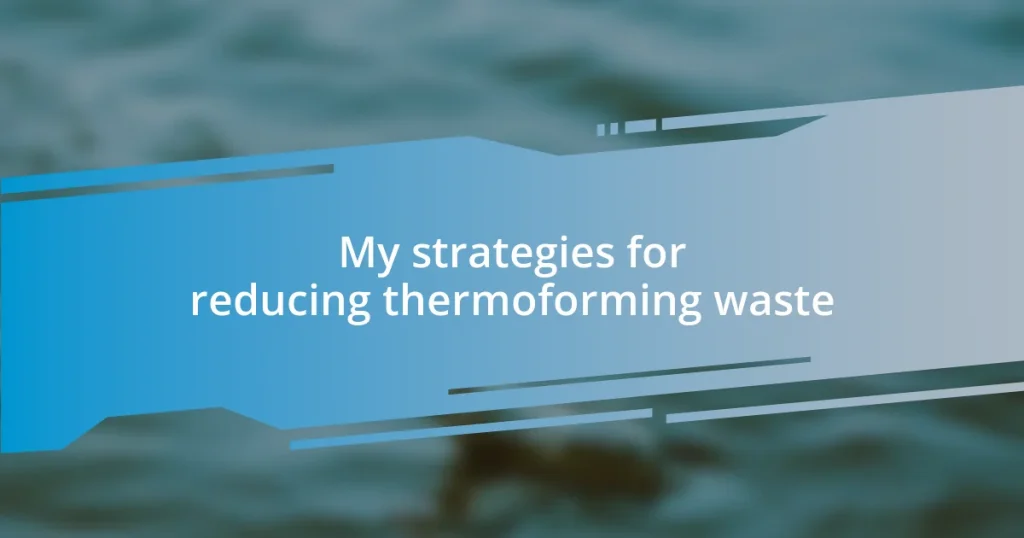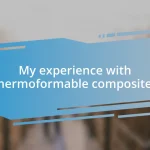Key takeaways:
- Optimizing thermoforming processes through efficient thermal management and accurate mold design significantly reduces waste and enhances sustainability.
- Choosing the right materials for production, focusing on recyclability and long-term efficiency, is crucial for minimizing waste output in thermoforming.
- Engaging and training staff on waste reduction techniques promotes collaboration and fosters a culture focused on sustainability and continual improvement.
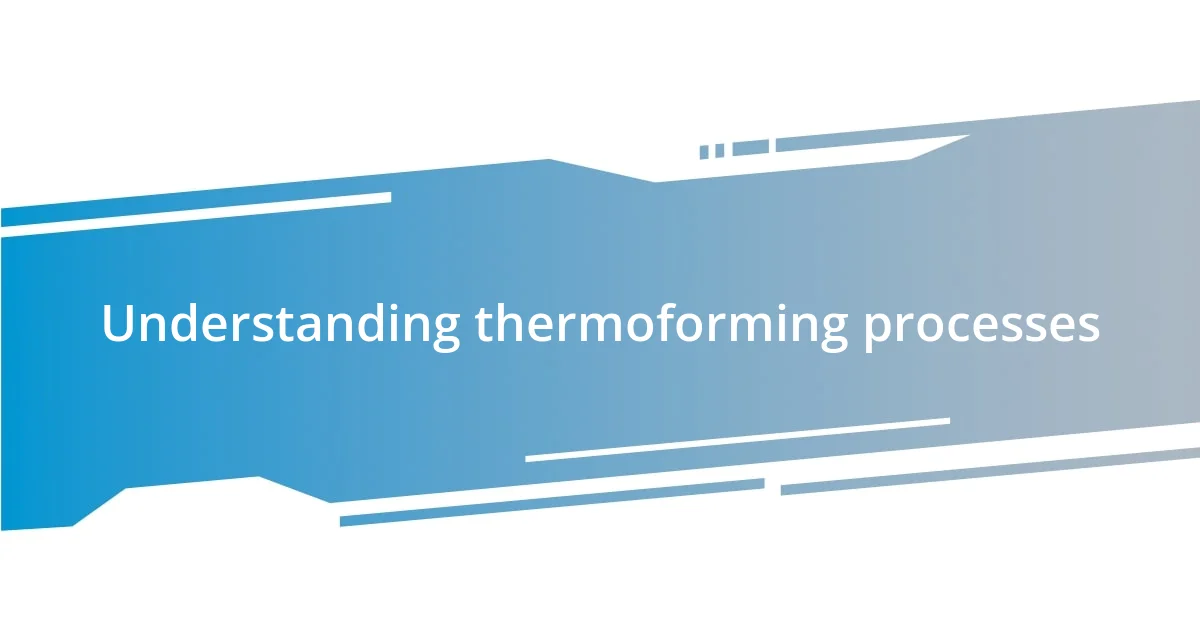
Understanding thermoforming processes
Thermoforming is a fascinating process that involves heating plastic sheets until they become pliable, then shaping them over a mold. I remember the first time I witnessed this in a factory; the transformation from a rigid sheet to a perfectly molded part was mesmerizing. It’s like watching a sculptor work, except this sculptor uses heat and pressure rather than chisels.
As the plastic cools, it retains the shape of the mold, creating a wide variety of products, from packaging to automotive parts. Have you ever considered how essential this process is in our daily lives? It struck me how that seemingly simple sheet can evolve into something functional and, more importantly, how critical it is to reduce waste during this process.
Efficient thermal management is key, as excessive heat can lead to material degradation and, ultimately, waste. I recall a project where optimizing the heating phase significantly reduced our scrap rate. It’s experiences like these that underscore the importance of precision in thermoforming, making every part molded not just a product but a step towards sustainability.
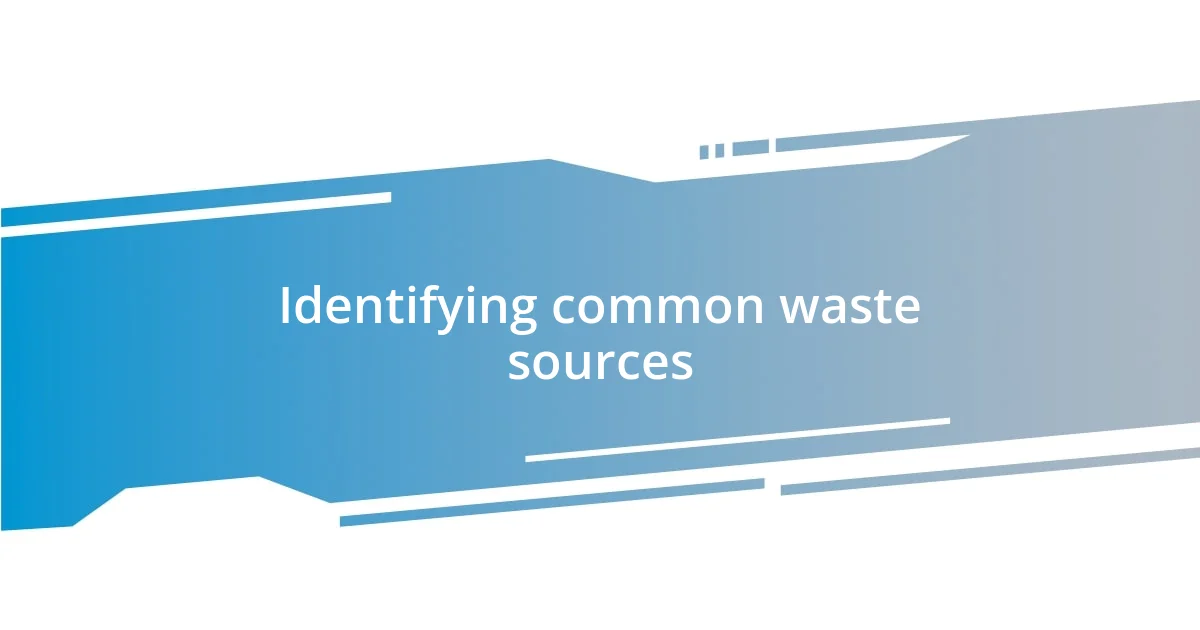
Identifying common waste sources
When I first started in the thermoforming industry, identifying waste sources felt overwhelming. I quickly learned that waste comes in various forms, often hidden in plain sight. It’s enlightening to think about how the production process can be fine-tuned to minimize these waste streams, which not only improves efficiency but also enhances sustainability.
Here are some common sources of waste in thermoforming:
- Trimming Losses: Excess material removed after forming can lead to substantial waste if not managed properly.
- Overheating: This can cause degradation of material, leading to unusable outcomes.
- Inaccurate Molds: Molds that do not match the product specifications may result in increased scrap.
- Changeover Waste: Switching between different runs can leave leftover materials that are often discarded.
- Quality Control Failures: Parts that don’t meet specifications often end up as waste, highlighting the need for better monitoring.
Reflecting on these points makes me realize how critical it is to evaluate each phase of the process regularly. For instance, during a recent project, I discovered that by improving our mold design, we not only reduced trimming losses but also enhanced the final product’s quality. Each step has the potential for waste, but with keen observation and targeted improvements, we can turn those challenges into opportunities for innovation.
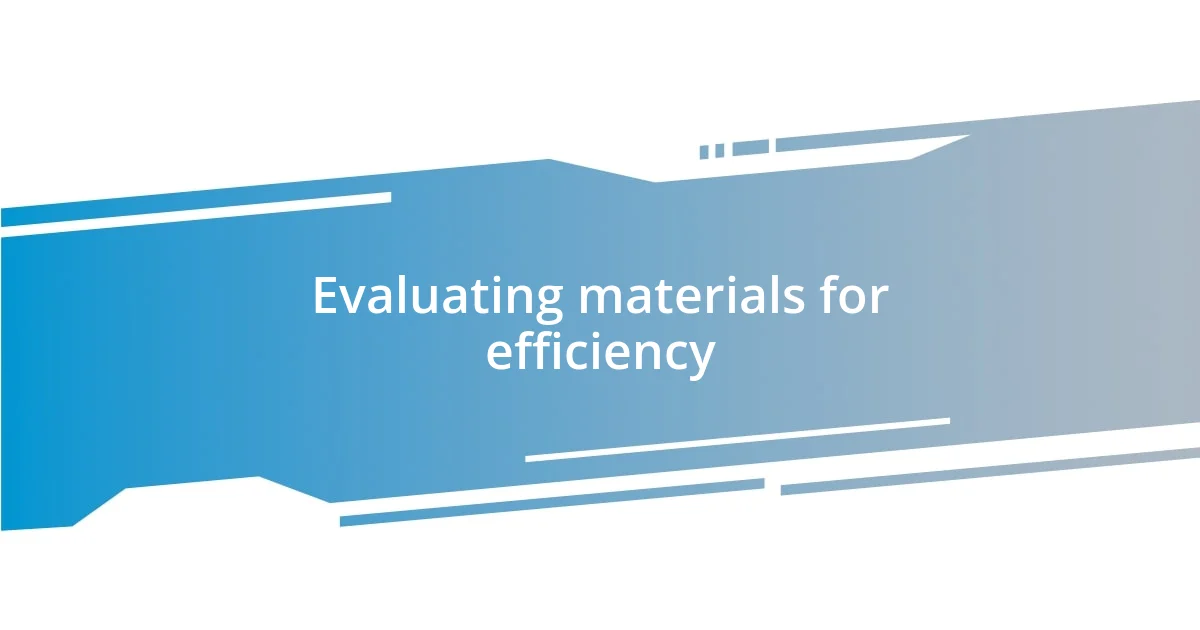
Evaluating materials for efficiency
When it comes to evaluating materials for efficiency in thermoforming, I’ve learned that not all plastics are created equal. For instance, some materials might work well but yield inconsistent results, leading to more waste. I once worked on a project where we tested two different plastic types side by side, and the variation in waste output was striking. It made me realize the importance of thorough material assessment—finding a material not just for its performance but also for its waste reduction capabilities is crucial.
To streamline our operations, I’ve often compared the recyclability of different materials. In one case, selecting a recyclable plastic significantly reduced our overall waste footprint. The sense of accomplishment we felt was palpable when we saw how a simple material choice could lead to environmental benefits. It’s moments like these that drive home the point: evaluating materials isn’t merely a technicality; it has real-world implications for sustainability.
I also keep a close eye on material costs versus their efficiency in production. While cheaper options might allure you initially, they could end up costing more in terms of waste. I vividly recall choosing a slightly more expensive high-quality film. Sure, it stretched our budget for a moment, but the reduction in scrap was worth every penny. In the end, it’s about balancing initial investments with long-term efficiency gains that keeps my commitment to reducing thermoforming waste strong.
| Material | Recyclability |
|---|---|
| Polyethylene (PE) | High |
| Polystyrene (PS) | Low |
| Polyvinyl Chloride (PVC) | Medium |
| Polypropylene (PP) | High |
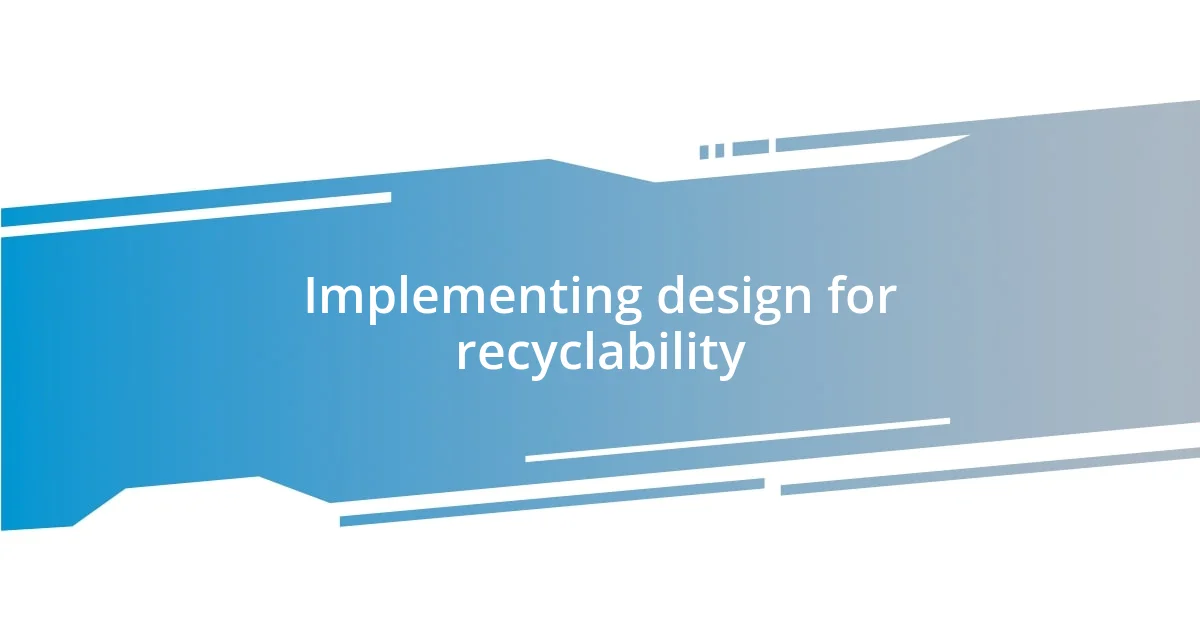
Implementing design for recyclability
One of the most profound lessons I’ve learned in thermoforming is the significance of designing for recyclability from the outset. I recall a project where we switched to a recyclable design, and the change was nothing short of transformative. Not only did we reduce waste significantly, but the team felt a new sense of pride knowing our work positively impacted the environment. Isn’t it exhilarating to think that the designs we choose today could lead to a more sustainable tomorrow?
As I dived deeper into this approach, I found that focusing on the end-life of our products at the design phase made all the difference. We began to consider not just how the product functions but how it could be disassembled and recycled. I remember a vivid brainstorming session with colleagues, where we mapped out the entire lifecycle of our new products. It felt empowering to think that even our design choices could influence the recycling process down the line. How often do we pause to consider if our creations can rejoin the materials cycle once their initial purpose has been fulfilled?
Ultimately, what resonated with me was the idea of material compatibility. I vividly remember a situation where my team had to deal with a mixed-material product that was nearly impossible to recycle. The frustration we felt was palpable when we realized our oversight had led to unnecessary waste. So now, I engage with my design team to assess the materials in every project, ensuring that they align not just with production goals but also with recycling capabilities. It’s a small change in mindset that leads to significant benefits—both for our operations and the planet.
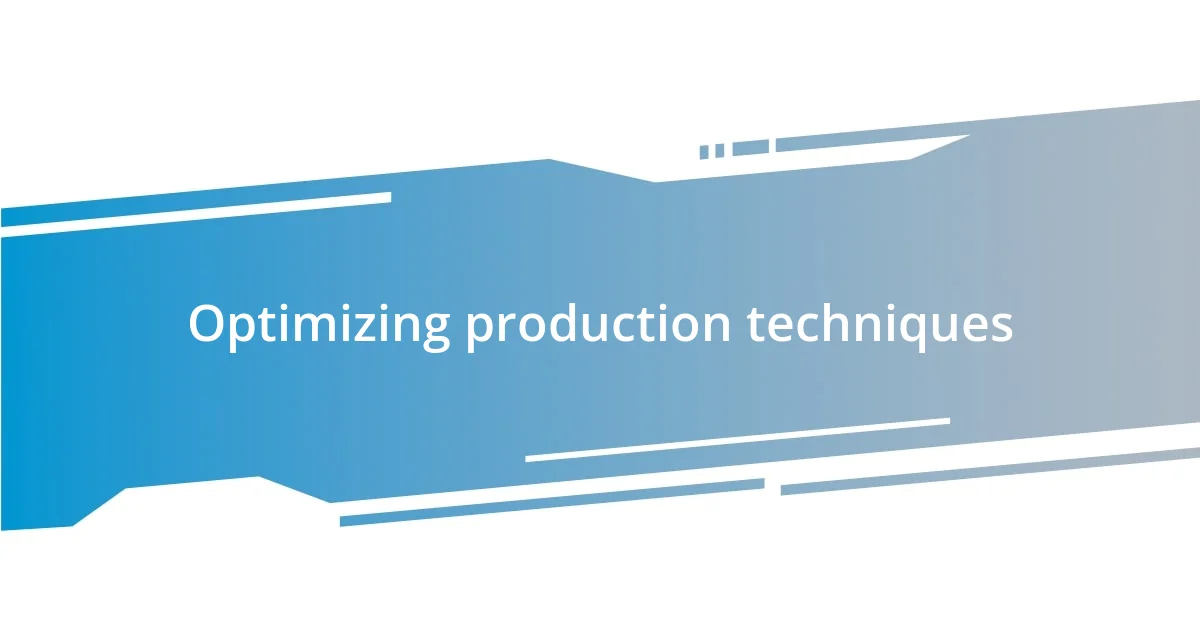
Optimizing production techniques
Optimizing production techniques in thermoforming has been a game-changer for me and my team. When we implemented a lean manufacturing approach, we were able to identify bottlenecks in our process that were previously overlooked. I remember one specific instance where we fine-tuned our machine settings, which not only enhanced efficiency but also significantly reduced scrap rates. Seeing the immediate impact of those adjustments reinforced my belief in continuously refining our methods.
Another strategy that has made a tremendous difference is embracing real-time monitoring of production processes. By integrating sensors and data analytics, we could catch potential waste issues before they escalated. I was truly amazed one day when a monitoring alert on our dashboard prompted us to address a minor misalignment in machinery before it resulted in tons of wasted material. It’s moments like these that lead me to wonder: how many waste issues go unnoticed without the right technology in place?
Training our staff is essential too, as everyone plays a role in waste reduction. I’ve held workshops where employees share their insights on optimizing production techniques. One team member shared a simple tip about reorganizing tools for quicker access, which resulted in less downtime during production runs. This collaboration not only fosters a culture of creativity but also actively engages everyone in the mission to minimize waste. What can be more fulfilling than uniting as a team to tackle a shared goal?
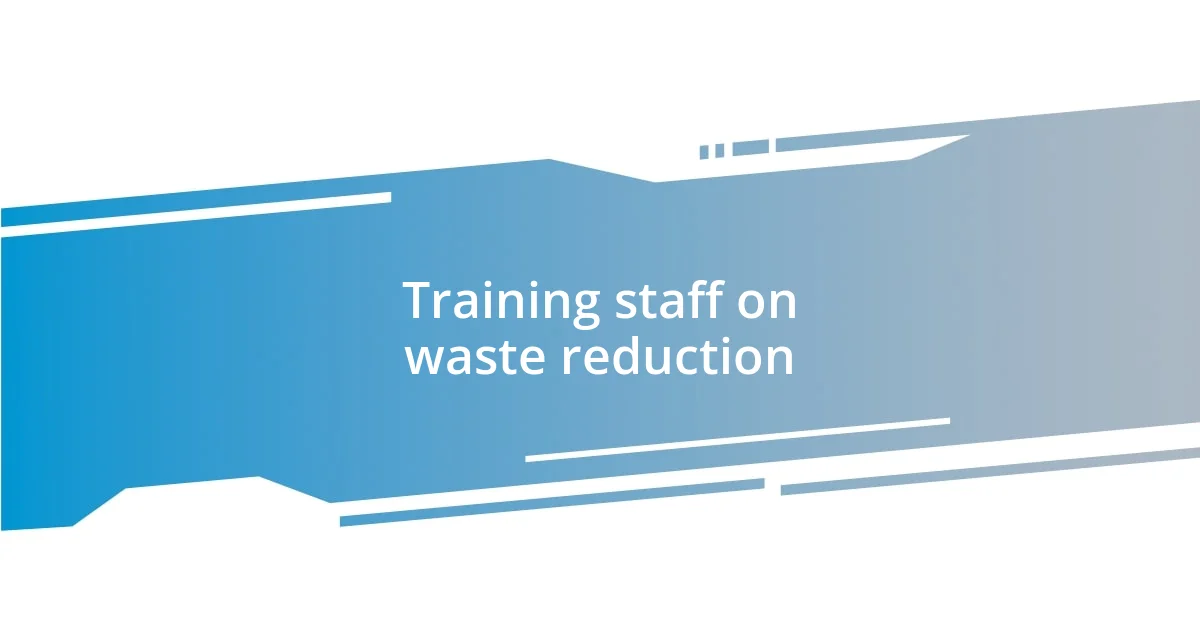
Training staff on waste reduction
Training staff on waste reduction has proven invaluable in my experience. When I first implemented a training program, I didn’t expect the level of engagement it would spark among team members. During a session, one employee shared how they repurposed off-cuts into smaller products, which ignited a discussion that led to several innovative solutions. Listening to their insights made me realize that everyone wants to contribute to a more sustainable future.
I quickly learned that educating our staff about the environmental impacts of waste can inspire them to adopt more sustainable practices. For instance, when I initiated a challenge to reduce waste at our facility, the ideas that emerged were nothing short of impressive. One individual even developed a tracking system to monitor waste production, and I still use it today. It’s amazing how a simple training initiative can lead to an empowered workforce dedicated to minimizing our environmental footprint.
Additionally, I make it a point to hold regular review sessions to discuss our waste reduction goals. I’ve noticed that when team members see their contributions leading to tangible results, their motivation skyrockets. I remember one productive meeting where we celebrated hitting a major milestone in reducing scrap. The energy in the room was palpable, and it reminded me that training isn’t just about imparting knowledge—it’s about fostering a community that thrives on shared success and commitment to sustainability. How often do we take the time to celebrate these small victories together?
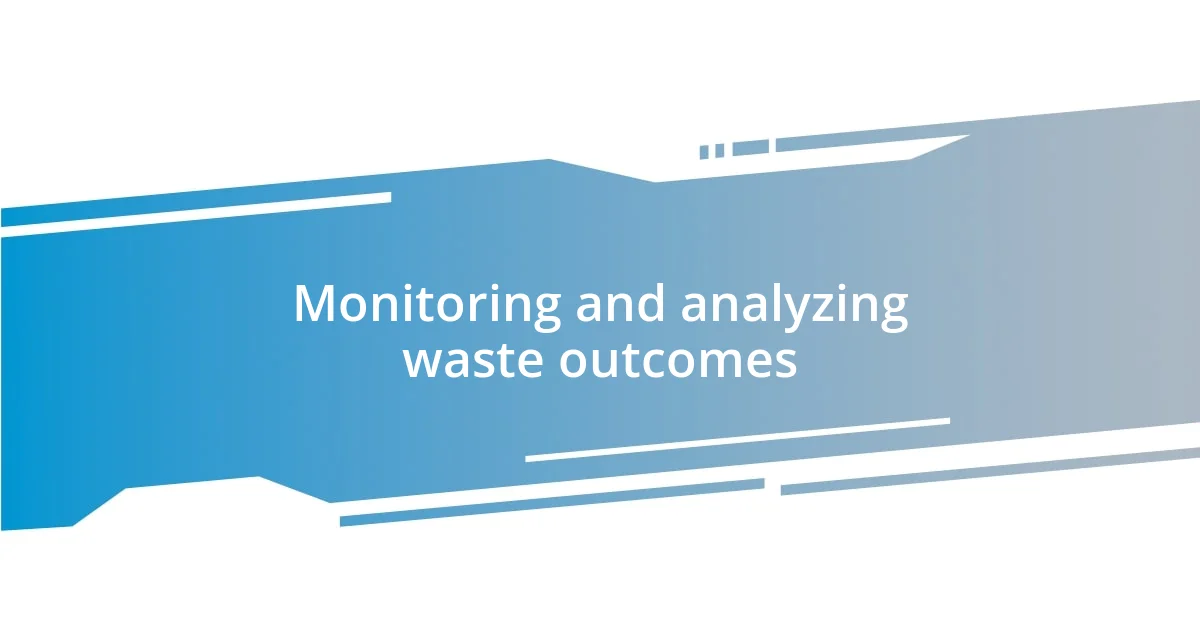
Monitoring and analyzing waste outcomes
Monitoring and analyzing waste outcomes is a crucial step in understanding where our resources go in the thermoforming process. I recall one particular instance when I began tracking our waste metrics more closely. Not only did it shed light on the types of materials we were losing, but it also highlighted specific areas in our operation that needed urgent attention. It felt like shining a spotlight on hidden problems, and I realized that simply observing was the first step toward meaningful change.
As I dug deeper into the data, I discovered patterns that surprised me. For example, a spike in waste during certain production runs corresponded to shifts in operator experience levels. This realization prompted me to pair less experienced staff with veterans to foster mentorship moments. It’s fascinating how data can reveal insights we might overlook otherwise, prompting real relationship-building among team members while tackling waste together. Have you ever thought about how analytics could enhance team collaboration in achieving sustainability goals?
The tools we use to monitor waste, like software for tracking material usage, have transformed how I approach production analysis. I remember several late nights spent combing through reports, feeling both frustrated and enlightened as I pieced together the narrative of our waste generation. The minute I could visualize our waste outcomes, it became clear where we needed to pivot. Engaging with data not only equips us with the knowledge to minimize waste but also inspires a proactive mindset. Isn’t it liberating to recognize that every statistic is an opportunity for improvement?











